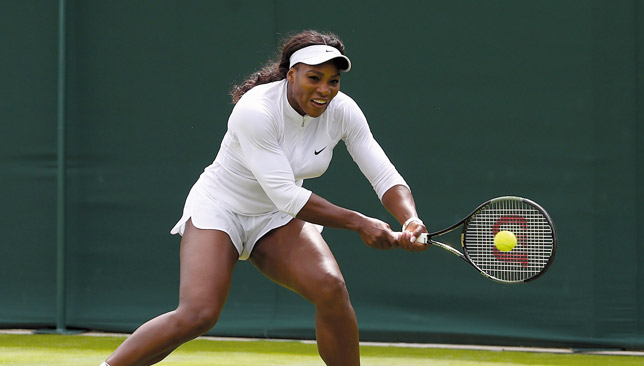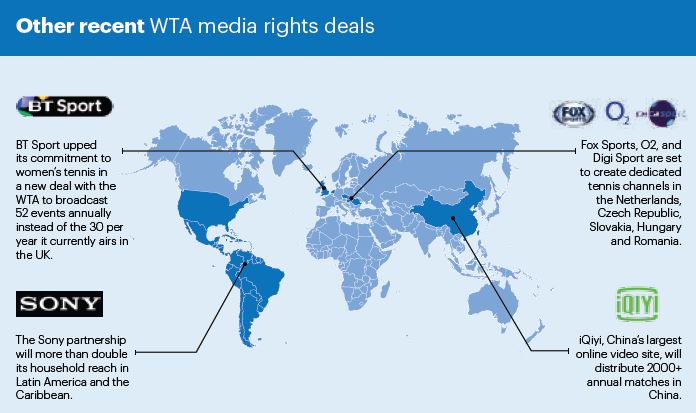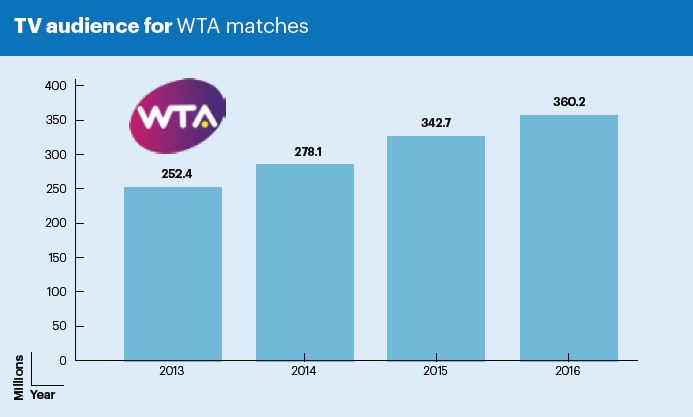
It’s no secret that women’s tennis gets less air time than the men’s on television in the Gulf region.
And while you can easily catch an ATP first round in Halle or Queen’s, finding a Serena Williams opener at a WTA tournament live on TV here is often a fool’s errand.
The reason is that the current deal between the WTA and beIN Sports – the main rights-holder in the Middle East and North Africa (MENA) region – only mandates that the network air the matches from the quarter-finals onwards of Premier-level tournaments.
That means a maximum of seven women’s matches are broadcast on beIN from one tournament.
So if a big star loses in an early round, or you want to follow a lesser-known female player who is unlikely to make it to the latter stages of a WTA event, you wouldn’t expect to find it on TV.
But that is going to change come next season as the WTA have signed a five-year multi-territory deal with beIN Sports that will allow the network to have access to four times as many matches as it does right now.
The agreement gives beIN broadcast rights for all WTA tournaments, including 21 Premier events, the BNP Paribas WTA Finals Singapore presented by SC Global, and 28 International-level tournaments in over 30 territories worldwide including Spain, the USA, Australia and the MENA region.
It comes after another big move in the world of tennis from beIN, who have secured the rights for Wimbledon this year, after outbidding previous holders, Abu Dhabi Sports.

“Now we’ve stepped up our game, and our mandate is that every main draw singles match is produced across every tournament and we’ve increased our number of minimum World Feed matches across every tournament,” WTA Media managing director John Learing (right) told Sport360.
“So someone like beIN will be able to access almost four times as many matches as they currently are able to.”
According to Learing, the beIN agreement will allow the WTA to reach more diverse demographics and potentially increase the fan-base in key markets such as the United States and France.
The deal ties in with the start of the WTA’s new partnership with leading digital sports content and media group, Perform, creating WTA Media – the tour’s dedicated media arm.
The live media rights and production deal is worth $525m over 10 years (from 2017 to 2026), the largest in the history of women’s sports.
The WTA have aggregated the majority of its international broadcast rights under one umbrella, and will be producing for television every singles match at every tournament.
“It’s new for tennis,” said WTA CEO Steve Simon. “The WTA had the foresight to pool all of its international rights. The domestic rights are still controlled by the local tournaments.
“But the international rights are now in one pool and we sold them together so that we could go on in and now commit to producing each and every match as well as deliver it to a partner such as beIN. So we are the only one that’s done that so far in tennis and I think it’s terrific and good for everybody.
“It’s obviously a lot of product and I think the one thing that makes tennis a little bit unique is that we have live, new product, seven days a week for 43 weeks out of the year, so that’s great value as well.”

Besides the increased access to produced matches, broadcasters now get the added benefit of localisation.
If Oman’s Fatma Al Nabhani or Tunisia’s Ons Jabeur are playing a first round in Doha on an outside court that is usually not televised, under the new deal, Qatar’s beIN can choose to broadcast their matches in order to cater for its viewers in the Gulf region.
“It’s also the beauty of the broadcasters that we are partnering with now in 2017 and beyond, they also have incredibly progressive OTT (over-the-top) platform footprints and so those matches that might not be available on television, will be available across their digital and their OTT service,” added Learing.
“So most broadcasters, and beIN of course are leading this, are committing not just the linear play but the digital play as well.”
Did you hear? @WTA signed an exclusive deal with beIN MEDIA GROUP covering 30 territories worldwide including the US https://t.co/uK74olGly9
— Valerie Boldrin (@valerieboldrin) May 17, 2016
The WTA started the process of selling their new bundle of rights to different markets around eight months ago and according to Learing’s estimates, they’ve got 70 per cent of the world covered at the moment.
“We’re currently in 177 territories or countries with our broadcast plan and the goal is to meet or beat that by January 2017. We’ll be darn close to beating that,” says Learing.
The investment put into producing all these matches is obviously a huge commitment but Learing believes it is already paying off.
Simon says the beIN deal is “one of the largest deals that we’ve done” while Learing explains how the new set-up is meant to be beneficial for everyone.
“It is paying off,” says Learing. “We’re trying to put as much money back into the tournaments’ pocket as possible so we’re giving each tournament across the WTA a couple of options.

“One option is that WTA Media, a production company we’re in the process of creating right now, will come on-site and produce all of your matches at no cost to the tournament.
“However we also know that many tournaments have long-term existing relationships with their host broadcasters, so we don’t ever want to get in the way of that.
“So if a tournament wants to continue that arrangement, WTA Media will contribute a set price towards the production of every single one of those matches.
“It is a much larger investment in production no matter which way, or which decision you choose, but WTA is making the financial commitment to make it work for as many as possible without them spending one more cent on production. And so far we’ve found our tournaments to be incredibly receptive.
“We had well over half of our tournaments accept our offer to become their host broadcaster, and for those who aren’t able to or want to continue with their current host, they’re very receptive to our contribution.”